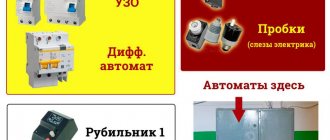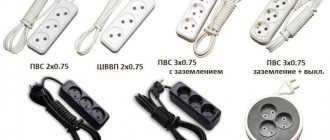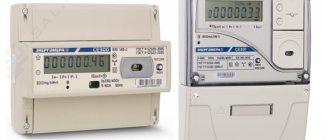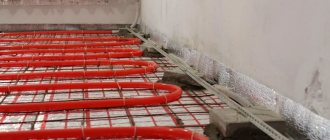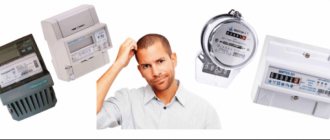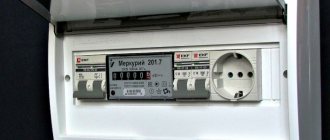Recently, heating systems based on electric convectors have become widespread for heating houses, especially where there is no possibility of connecting mains gas or such connection is very expensive. Compared to heating using the “boiler - water radiators” scheme, heating with electric convectors has undeniable advantages. It is environmentally friendly, it does not require premises for a boiler room or fuel storage, it is easy to install, has low inertia, is reliable and predictable, does not require maintenance, and is much cheaper in terms of equipment and installation costs. The widespread use of heating with electric convectors is hampered by stereotypes that convectors are exclusively auxiliary heaters in addition to the main heating, that they are suitable only for small houses with an area of 80-100 sq.m., that they have the highest energy consumption compared to other types of electric heating, in in particular, compared to heating with an electric boiler.
The electric convector is no longer an auxiliary heater Source home-comfort.ru
Unlike inexpensive convectors with a minimal set of functions, modern convectors are practically different heating devices, the task of which is not just to heat, but to heat wisely. Therefore, on their basis it is possible to install a full-fledged heating system.
Let’s define the terminology of what is considered a full-fledged permanent heating system, and what is simply heating. A complete heating system is:
- possibility of autonomous safe operation for a long time without human presence;
- ease of management, both individual elements of the system and the entire system as a single device, including remotely;
- energy efficiency is a set of devices and technologies that optimize the operation of the heating system to reduce energy consumption while maintaining comfort.
Let's consider the options for using electric convectors and evaluate them according to these criteria.
Heating by convectors with mechanical thermostats
The simplest heating, often used in summer cottages, is inexpensive convectors with a mechanical thermostat. The main capabilities of such convectors are adjusting the temperature with a knob or slider, choosing the operating power - full or half of the nominal value.
This type of convector is suitable for short-term or additional heating to the main heating and cannot be considered as full-fledged for year-round use. Such electric heaters do not use energy-saving technologies, their task is simply to heat, it is risky to leave them unattended (if the heater is an open filament), they operate with large errors of several degrees, each convector must be adjusted separately, and there is no possibility of control via the Internet. The use of GSM or WiFi sockets does not fundamentally change anything, except for the ability to remotely turn on and off an electrical appliance. Installing a room mechanical thermostat that controls several convectors will allow you to set the temperature from one device, but this is the only advantage of such a connection of convectors.
Scheme with a mechanical room thermostat Source home-comfort.ru
General requirements
In some cases, the best way out of the situation will be to install a gas convector. This heating device is mounted on the wall and is powered by a gas cylinder. The possibility of power supply from the main line is also provided. If gas appears in your locality in the near future, purchase gas convectors. The following requirements apply to their installation:
- Mandatory maintenance of distances to the nearest objects and walls in accordance with the installation instructions;
- The gas pipe is supplied along the street;
- When installing in a household with wooden walls, it is necessary to consider thermal insulation;
- The convector should not be installed at a great distance from the floor, as this will reduce the efficiency and intensity of the convection process.
Let's see how to install such a convector on a wall.
Heating by convectors with electronic thermostat
If there are several convectors and they are used for a long time, then simply heating is no longer enough. The first step towards energy efficiency is the ability to program temperature settings for weekdays, weekends, nights and daytime hours so that we can work economically when and where we need it in our weekly schedule. To do this, we will replace mechanical thermostats with electronic ones. An electronic thermostat is a thermostat, but with more precise adjustment of the on/off temperature, plus “brains” that allow you to configure the weekly cycle schedule and the main operating modes (comfortable, economical, minimal). Therefore, it is more correct to call an electronic thermostat a control unit.
Which heater to choose for a wooden house?
Heat a wooden house
The easiest way is to use directional devices operating from the mains.
... To create a comfortable temperature in wooden houses, the following types of safe heaters are considered the most popular:
- oil radiators;
- fan heaters;
- convectors;
- infrared emitters.
Interesting materials:
When will they start heating in St. Petersburg? When do holidays start in Bishkek? When do holidays start in Kazan? When do the holidays start in the Krasnodar region? When do holidays start in Kyrgyzstan? When do autumn holidays start in Dnipro? When do autumn holidays start in Kazan? When will the biathlon competition start? When will classes start at universities in Uzbekistan? When do students' winter holidays start?
Heating with convectors controlled via the Internet
We will continue to modernize the system. If the house is not permanently inhabited, then there is a need for remote monitoring and control of convectors via a mobile application. The mobile application is actually an extended heating system control console. In it you can add/remove heating devices, create separate zones, assign convectors to these zones, managing the zone as a separate device, set parameters for temperature conditions and the operating schedule of each device or zone. As a rule, a mobile application, in addition to controlling convectors, has the ability to control other climate control and household appliances - water heaters, ventilation, air conditioning, lighting, etc., becoming the control center of a smart home.
For such intelligent control, convectors must be connected to the Internet.
There are two most common solutions:
1. System based on inverter convectors. Each convector is equipped with an inverter control unit marked digital Inverter. Electrolux convectors of the Transformer System series with replaceable control units are suitable for this. The inverter control unit has all the same functions as the electronic unit, plus two key differences: the presence of a USB connector for installing a WiFi module for wireless communication with a WiFi router and a fundamentally different operating algorithm of the heating element - with automatic change of heating power.
General requirements
In some cases, the best way out of the situation will be to install a gas convector. This heating device is mounted on the wall and is powered by a gas cylinder. The possibility of power supply from the main line is also provided. If gas appears in your locality in the near future, purchase gas convectors. The following requirements apply to their installation:
- Mandatory maintenance of distances to the nearest objects and walls in accordance with the installation instructions;
- The gas pipe is supplied along the street;
- When installing in a household with wooden walls, it is necessary to consider thermal insulation;
- The convector should not be installed at a great distance from the floor, as this will reduce the efficiency and intensity of the convection process.
Let's see how to install such a convector on a wall.
Video description
Connecting a convector using a wifi module to the Hommyn mobile application:
Heating system on convectors with inverter control Source home-comfort.ru
2. Convector system with electronic thermostats and central controller. The operation of the convectors is controlled by a controller connected by a cable to a wifi router or GSM module. The convectors are connected to the controller either by wire or by radio signal (in this case, an individual device code is used). Convectors are controlled through a mobile application and through a controller.
Diagram of a heating system with a controller Source home-comfort.ru
The first scheme does not require the purchase of an expensive controller and is more convenient, since you just need to install a small WiFi module in the USB connector and register the device in the mobile application.
The second option is more expensive and more complicated, since you need to purchase not only special thermostats, but also a controller, which must be powered from a 220V network and connected with a LAN cable to a WiFi router, which is not always convenient and aesthetically pleasing when the controller is placed on the wall.
Besides these important differences, there is another key difference. A convector with a mechanical or electronic thermostat from any manufacturer operates in two states: either turned on at rated power or completely turned off. In an inverter convector, the heating power is regulated differently. It changes automatically depending on the difference between the set temperature and the current one, as well as the rate of change of this difference. This principle of proportional-integral control is often used in industrial systems and, when used in household equipment, allows achieving high energy efficiency compared to classic on/off heater power control.
The thing is that any heating device operating on the on/off principle always has a switch-on temperature and a switch-off temperature that differ from the set one. If the convector thermostat is very sensitive, then its on and off cycles will occur with high frequency, that is, in fact, the convector will constantly work, consuming energy, and in addition constantly load the network when turned on. That is why, in order to reduce the frequency of switching on, thermostats are set with a backlash of several degrees. The downside of this is the excessive work of the convector. Let us explain with an example: the temperature in the convector thermostat was set to 23 degrees. The minimum hysteresis (temperature range for turning on and off) is 2 degrees. The thermostat will turn off the convector at a temperature of 24 degrees, and turn it on at a temperature of 22 degrees. Trifle? If this is one convector that is used for several days, yes, it’s a small thing. And if there are 8-10 such convectors and they operate for 7 months of the heating season, then a large amount of electricity is consumed, because every extra degree of overheating is a plus of 5-10% to the heat consumption. And it doesn’t matter whether the convector is controlled by an external room thermostat connected to the controller or weather automation or the convector’s own thermostat. In online stores, the characteristics of a convector often indicate an electronic thermostat with an accuracy of 0.5°C. The nuance is that you can very accurately set the temperature on the electronic thermostat of the convector using buttons (in mechanical convectors this is done by eye), but this does not mean that the convector will accurately maintain the temperature at the set value. If the convector is controlled according to the on/off principle, it will work with a temperature saw around the set value. And the higher the thermostat hysteresis, the higher the excess electricity consumption over a long distance.
Design features
Externally, the unit is a rectangular solid body covered with a grille. The floor version looks like a small bench, the wall version is a panel of small thickness, and the built-in ones can be seen only thanks to the grille.
The classic casing is made of stainless steel. But, taking into account the design features of the room and the wishes of the clients, the body can be made of wood, marble chips or MDF panels.
Ascetic on the outside, the inside of the water heating convector is more complicated. Their “heart” is considered to be a heat exchanger, which is a flat copper pipe or a coil-shaped pipe. The lamellas are attached perpendicularly to it using a tight fit method.
The place where they are connected to the pipe should exclude the slightest gaps that reduce heat transfer. Copper is most often used to make plates; steel and aluminum options may be found, the main thing is that the thermal conductivity is high.
Connection to the riser or central pipeline is made through special threaded entries inside, which are located at the end of the device or on the side. Modern heating water convectors are equipped with tap valves or manual/automatic valves to release excess air that impairs heat transfer.
If the kit includes an electronic thermostat/thermostat, it will control the operating rhythm of the device. The heating process periodically stops when the set temperature is reached and starts again when the air cools.
To enhance air circulation, a fan is used, which is either already built-in or will have to be purchased. This useful addition (1-2 pieces) is found only in.
How convection helps you stay warm
Unlike conventional batteries, which warm the air by radiating heat from their surfaces, water heating convectors operate differently. They mix air masses, replacing warm air with cold air and creating a pleasant atmosphere. At the same time, there is no feeling of dryness and a specific unpleasant smell of burnt dust.
Hot water from the heating system enters the heat exchanger and heats the plates. Considering the thermal conductivity of the material used, as discussed above, the parts heat up very quickly. Through the holes in the grate, warm masses rise unhindered, being displaced by cold ones.
The built-in fan stimulates this process, and in a matter of minutes you can already feel the result. At the same time, the efficiency increases to 95%, which makes it appropriate to use water convectors in spacious rooms with large window and door openings.
In accordance with the requirements of GOST 20849-94, water heating convectors must have the primary inherent property - tightness and strength, which is checked by a test water pressure of 1.5 MPa. The heating elements and casing must be coated with an anti-corrosion, heat-resistant compound.
Among other things, water convector heating is relatively inexpensive, given its growing popularity. Installation of a wall, floor or plinth structure by specialists will cost you almost half as much as an in-floor structure. This price is justified by the complexity of the preliminary work on constructing a niche in the raised floor.
Brief characteristics of typical convectors
Their technical characteristics are important for water heaters; it is on their basis that a specific heater model is selected. The characteristics of most standard convectors are within the following limits:
The characteristics of most standard convectors are within the following limits:
- the maximum permissible pressure during operation is 16 bar;
- pressure testing – 25 atm;
- water temperature can reach 130 °C;
- maximum case heating – 60 °C;
- the heat exchanger can be 4 or 6 rows;
- the volume of water in the heat exchanger is 0.7–0.9 l;
- throughput per hour from 90 to 170 liters;
- power from 100 to 200 kW;
- weight ranges from 14 to 21 kg.
Video description
To find out which is more economical - an inverter heating system or heating using an electric boiler and radiators, see the following video:
Stereotype: Only for small houses
And in conclusion, regarding the prevailing opinion that convectors are only for houses with a small area with the number of heating points no more than 6. The objective disadvantages of a heating system with an electric boiler are characteristic of both small houses of 80-100 sq.m., and houses of a larger area. This means that the disadvantages of one system and the advantages of another are scaled to houses with a larger area of 200-300 sq.m.
What is convection?
The phenomenon of convection was taught at school as part of the physics curriculum. This is the transfer of energy by jets of liquid or gas. As you know, warm air always rises and cold air sinks. Another striking example is water that is heated in a kettle. When the cookware sits on a lit burner, the warmer liquid rises from the bottom, which ensures uniform heating overall. This process is called natural convection. Convection can also be forced. This is the work of a fan, pumps, etc., under the influence of which the transfer of liquids and gases occurs.
Several general recommendations for connecting electric convectors.
Installing a heating system on electric convectors does not require any special skills, even if you are not an electrician. General recommendations must be followed:
- Do not place a total load of more than 3 kW on one line (3 convectors of 1 kW each, or 2 of 1.5 kW each)
- Connect such a line through a differential circuit breaker of at least 15A
- When connecting in series to one load line more than 3 kW, use a contactor
- When using a room thermostat or a GSM socket not manufactured by the convectors, pay attention to the permissible current for it
Advantages and disadvantages of floor-mounted convectors
We list the positive and negative features of in-floor heaters without dividing them by the type of energy carrier used and listing the characteristics inherent in all convectors as a whole.
- due to the location of the unit, the lower, coldest layers of air are heated;
- installation of devices does not reduce the usable volume of the room;
- quick access to working mode;
- preventing the formation of condensation on glazing.
- with high ceilings, building natural convection units into the floor is not effective - convective flows of heated air are concentrated high under the ceiling and cool down before they fill the actual volume of the room;
- convection from the level of the floor covering initiates intense movement of dust in the air, which is constantly present in the air during heater operation;
- inconvenience of daily care of niches in which household waste accumulates.
How to choose a heating device by power
Step one is to determine the heat energy requirement for each room. Calculated according to SNiP or a simplified method - 0.1 kW per 1 m² of area. The choice of electric convectors is simple; the thermal power of each modification is indicated in the passport.
Table from the instructions for the electric convector from the Ballu brand
Choosing and buying a water floor heater is more difficult. The technical characteristics of the device indicate heat transfer under certain conditions, for example:
- t (temperature) of water in the supply pipeline – 75 degrees;
- return t – 65 °C;
- air t in the room – 20 °C.
If you send a coolant with a temperature of 60 °C into the convector, its power will decrease; you need to take the device with a certain reserve. To accurately determine the heat transfer value of a specific model, you should use the manufacturer’s data; there are no other options.
Reference. The Verano company publishes in the equipment data sheets a table of the power of each heating device under various operating conditions. Let us give an example of such a table for a convector with a height of 300 mm and a width of 284 mm.
Since the range of convection-type heaters is quite wide, it is unrealistic to lay out the technical parameters of all devices here. Therefore, to select the size of the convector, it is better to contact an online store consultant or visit the manufacturer’s official website.
Determining the number of aluminum battery sections
It is not easy to recalculate the parameters of a heating device for specific conditions. The thermal power formula and calculation algorithm used by design engineers are too complex for ordinary homeowners who are ignorant of heating engineering.
We suggest calculating the number of sections of heating radiators using a more accessible method that gives a minimum error:
- Collect the initial data listed in the first section of this publication - find out the amount of heat required for heating, the temperature of the air and coolant.
- Calculate the actual temperature difference DT using the above formula.
- When choosing a specific type of battery, open the technical data sheet and find the heat transfer rate of 1 section at DT = 70 degrees.
- Below is a table of ready-made conversion factors for the heating power of radiator sections. Find the indicator corresponding to the real DT and multiply it by the value of the rated heat transfer - get the power of 1 fin under your operating conditions.
Knowing the real heat flow, it is not difficult to find out the number of battery fins required to heat the room. Divide the required amount of heat by the output of 1 section. For clarity, here is an example calculation:
- Let's take a corner room with two translucent structures (windows) with an area of 15.75 m², ceiling height - 280 cm (shown in a fragment of the drawing). Specific heat consumption for heating is 130 W/m², the total requirement will be 130 x 15.75 = 2048 W.
- We found out the magnitude of the thermal pressure in the previous section, DT = 43 °C.
- We select low aluminum radiators GLOBAL VOX 350 (center distance - 350 mm). According to the product documentation, the heat output of 1 fin is 145 W (DT = 70 °C).
- We find in the table the coefficient corresponding to DT = 43 °C, K = 0.53.
- We multiply the nameplate power by the coefficient and find the real output of 1 section: 0.53 x 145 = 76.85 W.
- We calculate the number of aluminum fins per room: 2048 / 76.85 ≈ 26.65, round up and get 27 pieces.
All that remains is to distribute the sections throughout the room. If the window sizes are the same, we divide 28 in half and place a radiator with 14 fins under each opening. Otherwise, the number of battery sections is selected in proportion to the width of the windows (approximately possible). The heat transfer of bimetallic and cast iron radiators is recalculated in a similar way.
Many well-known companies, including GLOBAL, indicate in the documentation the heat transfer of their devices for different temperature conditions (DT = 60 °C, DT = 50 °C), an example is shown in the table. If your real ΔT = 50 degrees, feel free to use the specified characteristics without any recalculation.



